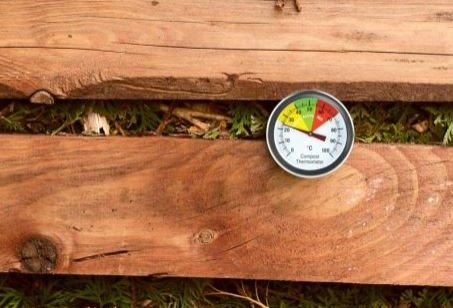How To Use A Compost Thermometer
Compost thermometers are not required in order to have a successful hot compost heap, but they are very helpful if you are experimenting with ways to increase the heat of your heap.
If you build two piles that are exactly the same except that one has activator and one does not, how will you know if the activator made a difference? A compost thermometer can tell you!
Children provide another good reason to keep a compost thermometer on hand. They love to see proof of a compost heap high heat, and may need to measure exact temperature for a school and project.


Taking a Compost Heap’s Temperature
A compost thermometer is about 30cm to 50cm (12 – 20 inches) long with a meter on one end. Grasping the metered end, thrust the thermometer into the pile so that the pointed tip is in the centre of the pile. Leave it in that position until the meter stops moving. The reading on the meter is the temperature of your pile.
I like to take three temperature readings at a time, rather than rely on a single reading. I do this because it is possible to hit a pocket of low activity which will produce a false reading. A false reading is one that does not reflect the temperature throughout the centre of a pile.
To take multiple readings, simply remove the thermometer and reinsert it into the pile so that it is in the pile’s centre but not the exact spot as the previous reading. If you do not happen upon a low-activity pocket, multiple readings should be within a few degrees of each other.
Compost Thermometer Will Confirm a Hot Compost Heap has been Built Correctly
Once you build a hot compost pile, it should heat to 60°C (140°F) or higher within 24-48 hours. Use your thermometer to check the compost heap starting 24 hours after it was built. If it hasn’t heated to that level after 48 hours, start troubleshooting.
Compost Thermometer Will Inform You When to Turn the Compost Heap
The heap’s heat will rise as long as it is providing a favourable environment for bacteria. Once the air and moisture become depleted, the bacteria population will contract and the pile’s temperatures will decrease. So, if you measure it once every day you will see a dramatic drop in temperature on the 4th or 5th day. When you see that, turn the pile, watering each 10cm to 15cm (4-6 inch) layer, to introduce additional air and water.
Take the temperature every day until you see another drop, and turn the pile again. This cycle will happen 4 or 5 times if you turn the pile each time the temperature drops. After that point, the temperature will remain stable, won’t heat up dramatically, and you can turn it every week or so.
What Else Can I Do With a Compost Thermometer?
- Ensure your pile is working without getting your hands dirty
- Conduct experiments
- Figure out the size of the “sweet spot” of your pile, i.e., the hot centre of the pile
- Determine the difference between the temperature at the bottom of the pile vs. the top, or the centre vs. the outer edges
- Find out if a sudden drop in ambient temperature affects your pile
- Ascertain whether a small pile has enough mass to heat at all
